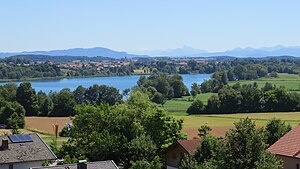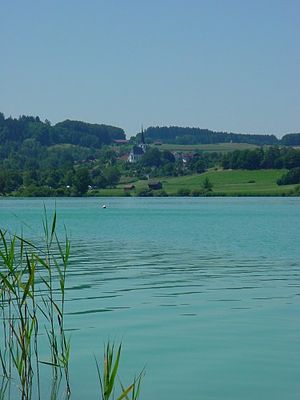Tachinger See
| Tachinger See | ||
|---|---|---|

|
||
| The lake in its surroundings | ||
| Geographical location | bayer. Alpine foothills | |
| Tributaries | Tenglinger Bach, Tachinger Mühlbach | |
| Drain | Waginger See → Götzinger Achen → Salzach → Inn → Danube | |
| Places on the shore | Tettenhausen (municipality of Waging am See ) |
|
| Location close to the shore | Taching am See , Tengling | |
| Data | ||
| Coordinates | 47 ° 57 '57 " N , 12 ° 44' 36" E | |
|
|
||
| Altitude above sea level | 442.1 m | |
| surface | 2.36 km² | |
| length | 3.65 km | |
| width | 888 m | |
| volume | 21,600,000 m³ | |
| scope | 9.25 km | |
| Maximum depth | 16.5 m | |
| Middle deep | 9.2 m | |
| PH value | 7.9 | |
| Catchment area | 31.8 km² | |
|
particularities |
connected to the Waginger See |
|

|
||
| Taching and Tachinger See | ||
The Tachinger See (mostly called Tachensee until 200 years ago ) is a lake in the eastern district of Traunstein in the Rupertiwinkel , which is almost four kilometers long and one kilometer wide. In common parlance, it is subsumed under Waginger See , which adjoins it to the south .
etymology
The Tachinger See got its name from today's climatic health resort Taching am See .
geography

Together with Waginger See , which adjoins it in the south , the lake is embedded in an arc shape in hills covered with fields and meadows. The Tachinger See, which is bordered in the east by a partially wooded steep bank, is only separated from the Waginger See to the south by a constriction bridged at Tettenhausen. This bottleneck is formed by a peninsula that extends into the lake from the west and is marked on old maps as Auerzipfel (after the nearby Einödhof Au or formerly Auerbauer ). It was narrowed in the 19th century by lowering the lake (by relocating and lowering the drainage) or backfilling from the east (from around 155 to 20 meters) so that a bridge could be built. The district road TS 26, or the main road of the municipality of Waging, which is locally called Hauptstraße from the east bank (district Tettenhausen) , leads over the bridge . In linguistic usage today, both lakes are combined to form the “Waginger See”, even if the natural spaces are different due to the constriction, e.g. B. differ in the average temperature. On Philipp Apian's land board from 1568, the Tahensee (there designation for the Tachinger See and the Waginger See) is drawn in without a distinctive constriction.
With a water temperature of up to 27 ° C in summer, the lakes are among the warmest lakes in Bavaria. Even so, they can freeze over in severe winters; until the 1960s this was the case almost every year. The Tachinger See freezes over a few days earlier than the Waginger See because of the lower average temperature and probably also because of the lower currents.
Communities
Together with Waginger See, Tachinger See forms the community-free area Waginger See . One of two community-free areas in the Traunstein district , the other is the community-free area Chiemsee . As in common parlance for the lake, the name of the community-free area Waginger See also includes Tachinger See.
Two communities border the Tachinger See on the shore: Taching am See in the west and north (Tengling district there), and Waging am See in the east (only with its Tettenhausen district).
geomorphology
Like so many lakes on the edge of the Alps, glaciers from the last Ice Age shaped the landscape so that Waginger and Tachinger See could arise. Of a formerly extensive lake district the near vicinity, the water level by about 20 meters higher than today was, remained next to the Abtsdorfer See , the slowly silted Weitsee and the silted already in historical times Schönramer felt , both south of Petting located in Rupertiwinkel only the Tachinger See and Waginger See left.
Hydrology
The lake is fed by several streams and drained via the Waginger See. The most important tributaries are the Tenglinger Bach in the north and the Tachinger Mühlbach in the west. The other tributaries, mostly in the west, are unnamed. There are no significant tributaries in the east. The runoff takes place in the south through the narrow point at Tettenhausen into the Waginger See.
Sea fluctuations

In 1905, Anton Endrös examined the sea fluctuations in the Waginger See and Tachinger See. He found over 10 oscillations of different duration . The largest fluctuation was 75 mm, with twice the amplitude mostly remaining below 18 mm. The longest uninodal longitudinal oscillation extends over both lakes and has an average duration of 62 minutes, with the knot lying between the two lake constrictions. The Tachinger See had its own uninodal longitudinal oscillation of approx. 13 minutes of average duration and a binodal oscillation of approx. 6 minutes. Multi-nodal vibrations were also found, all of them under 10 minutes.
See also
Individual evidence
- ↑ a b c d e f Documentation of the condition and development of the most important lakes in Germany: Part 11 Bavaria (PDF; 1.7 MB)
- ^ Original position sheet 746 Waging (1865/66). Here the two lakes are still referred to as Waginger See .
- ↑ Historical land map
literature
- Anton Endrös : Die Seiches des Waginger-Tachingersees , session reports of the mathematical-physical class of the KB Academy of Sciences in Munich, Volume XXXV, year 1905, pages 447–476
